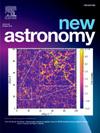An MHD simulation of the possible modulations of stellar CMEs radio observations by an exoplanetary magnetosphere
IF 2.1
4区 物理与天体物理
Q2 ASTRONOMY & ASTROPHYSICS
引用次数: 0
Abstract
Type II radio bursts are the indicator of adverse space weather in a stellar system. These radio bursts are the consequence of shock wave acceleration due to the coronal mass ejection (CME). In this study, we conduct a series of magnetohydrodynamic (MHD) simulations of CME-driven star–planet systems to investigate how close-in exoplanets modulate radio burst characteristics. We use a model for the stellar wind with a close-in exoplanet, and a CME model based on the eruption of a flux rope. We are able to generate synthetic radio burst images from our MHD simulations. We find that radio burst like phenomena is most likely to be observed for moderately active solar like stars and close-in exoplanetary systems have significant influence on the nature of radio burst spectrum. We find that when the exoplanet’s magnetic field is relatively weak, its magnetosphere compresses the CME plasma, increasing local density and shifting the radio emission to higher frequencies. Conversely, a strong planetary magnetic field results in a large magnetosphere that prevents effective CME-shock development, producing weaker radio emission concentrated at lower frequencies, particularly at the flanks of the CME. For highly active solar-like stars, strong overlying stellar magnetic fields suppress the CME shock, greatly diminishing radio burst visibility. For HD 189733 (moderate stellar field), only intensity difference is visible when the CME arrives the planet. We also do not find significant modulation in the radio emission by a close-in exoplanet system when the stellar magnetic field is complex. In summary, our findings highlight that the nature of the radio burst spectrum is strongly dependent on both the topology of the stellar magnetic field and the magnetic strength of close-in exoplanets.
通过系外行星磁层对恒星cme射电观测可能调制的MHD模拟
II型射电暴是恒星系统中不利空间天气的指示。这些射电暴是由于日冕物质抛射(CME)引起的冲击波加速的结果。在这项研究中,我们对cme驱动的恒星-行星系统进行了一系列磁流体动力学(MHD)模拟,以研究近距离的系外行星如何调制射电暴特征。我们使用了一个有近距离系外行星的恒星风模型,以及一个基于通量绳喷发的CME模型。我们可以通过MHD模拟生成合成的射电暴图像。我们发现,类射电暴现象最可能出现在中等活动的类太阳恒星上,而近距离的系外行星系统对射电暴频谱的性质有重大影响。我们发现,当系外行星的磁场相对较弱时,它的磁层压缩CME等离子体,增加局部密度,并将无线电发射转移到更高的频率。相反,一个强大的行星磁场导致一个大的磁层,阻止了CME冲击的有效发展,产生较弱的集中在较低频率的无线电发射,特别是在CME的侧面。对于高度活跃的类太阳恒星,强大的覆盖恒星磁场抑制了CME冲击,大大降低了射电暴的可见性。对于HD 189733(中等恒星场),当日冕物质抛射到达行星时,只有强度差异是可见的。当恒星磁场复杂时,我们也没有发现近距离系外行星系统的无线电发射有明显的调制。总之,我们的发现强调了射电暴频谱的性质强烈依赖于恒星磁场的拓扑结构和近地系外行星的磁场强度。
本文章由计算机程序翻译,如有差异,请以英文原文为准。
求助全文
约1分钟内获得全文
求助全文
来源期刊

New Astronomy
地学天文-天文与天体物理
CiteScore
4.00
自引率
10.00%
发文量
109
审稿时长
13.6 weeks
期刊介绍:
New Astronomy publishes articles in all fields of astronomy and astrophysics, with a particular focus on computational astronomy: mathematical and astronomy techniques and methodology, simulations, modelling and numerical results and computational techniques in instrumentation.
New Astronomy includes full length research articles and review articles. The journal covers solar, stellar, galactic and extragalactic astronomy and astrophysics. It reports on original research in all wavelength bands, ranging from radio to gamma-ray.
 求助内容:
求助内容: 应助结果提醒方式:
应助结果提醒方式:


